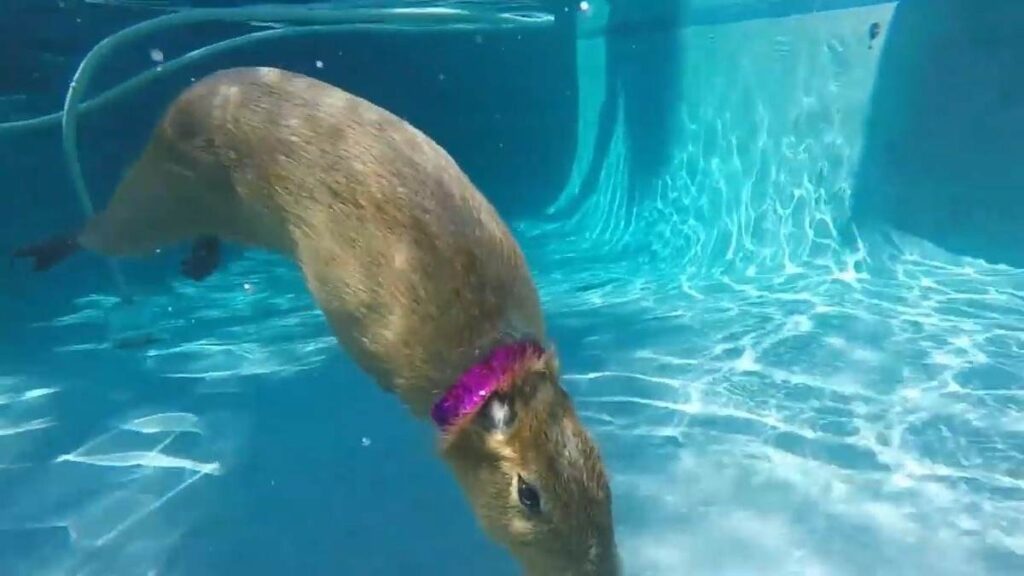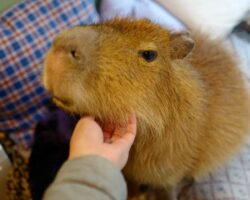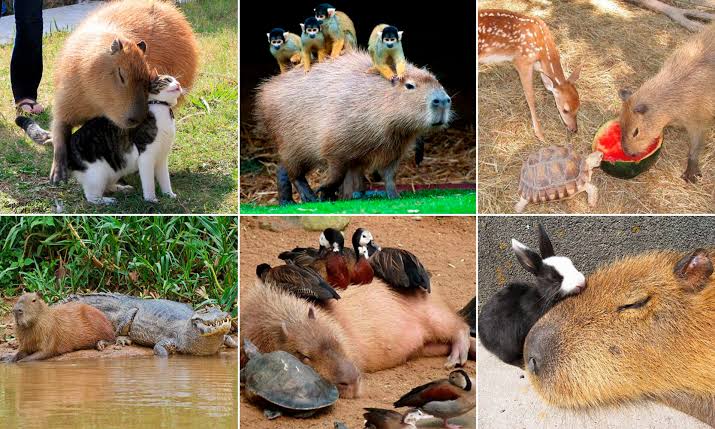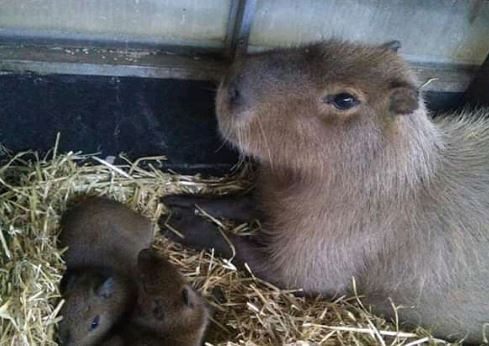Capybaras are captivating creatures with unique characteristics and behaviors. They are also highly sociable creatures who live in herds. As semi-aquatic animals, they have a natural affinity for water and swimming, deeply ingrained in their biology.
Capybaras have a dense, waterproof coat that allows them to spend prolonged periods in the water. Swimming provides them with exercise and helps regulate body temperature and maintain healthy skin. Additionally, water is a source of hydration and enables capybaras to engage in their natural behaviors, such as socializing and foraging.
Having a proper pool for your pet capybara offers numerous benefits. It allows them to express their instincts and behaviors, promoting physical and mental stimulation. The pool provides an opportunity for exercise, essential for keeping capybaras fit and healthy. In this article, we will explore everything you need to know about pool sizes for pet capybaras.
Understanding the Needs of Pet Capybaras
Capybaras are the largest rodents in the world and are semi-aquatic. They have a natural affinity for water and are excellent swimmers. Their bodies are well-adapted to swimming, with webbed feet and the ability to close their ears and nostrils to prevent water from entering.
They have unique needs that require careful consideration to ensure their well-being. Providing a proper pool for pet capybaras is crucial for their physical and mental health. Here are some benefits of a suitable pool.
- Exercise and Physical Health: Capybaras are active animals that require regular exercise to maintain their physical health. Swimming in a pool allows them to engage in their natural behaviors, providing a low-impact form of exercise that strengthens their muscles and improves cardiovascular health.
- Temperature Regulation: Capybaras are susceptible to overheating due to their dense fur. Access to a pool allows them to regulate their body temperature by immersing themselves in the water, especially during hot weather. It helps them cool down and prevents heat-related stress.
- Stress Relief and Mental Stimulation: Water is a source of relaxation and stress relief for capybaras. It provides them a natural and enjoyable environment to swim and socialize. Swimming and exploring the pool can also provide mental stimulation, preventing boredom and promoting well-being.
- Skin and Coat Health: Water helps keep capybara skin and coat healthy. Swimming in a clean pool removes dirt, debris, and parasites, reducing skin issues risk and promoting a healthy, shiny coat.
Why Do They Put Oranges in Capybara Baths?
Can You Own a Capybara in Pennsylvania?
Determining the Pool Size for Pet Capybara
When determining your pet capybaras’ minimum pool size requirements, several factors must be considered. Here are some of the factors below.
- Capybara Size: Capybaras grow large, with adults typically weighing between 70 and 150 pounds. The pool should be spacious enough to accommodate the capybara’s size, allowing them to move around comfortably and engage in natural swimming behaviors.
- Activity Level: Capybaras are active animals and enjoy swimming and playing in the water. Consider the capybara’s activity level and provide a pool size that allows ample space for swimming, diving, and other water-related activities.
- Social interaction: Capybaras are sociable animals and often live in small groups. It’s imperative to consider the number of capybaras sharing the pool. The pool should be large enough to accommodate multiple capybaras simultaneously, providing space for social interaction and group swimming.
- Ample Swimming Space: Capybaras are natural swimmers and require sufficient space to swim and exercise. The pool should have dimensions allowing long swimming stretches, enabling the capybara to engage in their preferred aquatic behaviors.
Getting the Depth Right
The ideal depth range for a capybara pool should facilitate their natural swimming behaviors. It should provide both shallow and deep areas for them to choose from. Generally, depth ranges should be between 2 and 4 feet.
There should be shallow areas within the pool that allow capybaras to wade and enter the water comfortably. This is especially relevant for younger or smaller capybaras that may be less confident swimmers.
There should also be deeper areas in the pool that allow them to submerge themselves and exhibit their natural swimming abilities fully. This depth range enables them to engage in instinctual behaviors, such as diving, exploring underwater, and swimming for exercise.
In addition to depth and size, it is important to consider water level maintenance and safety factors. Here are some of them below.
- Monitor the water levels: Regularly check and maintain the pool water level to ensure it remains within the desired depth range. Avoid letting the water level drop too low, as it may restrict capybaras’ swimming abilities.
- Gradual slope or ramp: Provide a gradual slope or ramp in the pool to allow capybaras to enter and exit the water easily. This helps prevent accidents or injuries when attempting to climb steep pool edges.
- Non-slip surfaces: Use non-slip materials or coverings on the pool floor and edges to prevent capybaras from slipping and injuring themselves while moving around the pool.
- Water quality and filtration: Maintain proper water quality and filtration systems to ensure the pool remains clean and free of harmful bacteria or contaminants. Regularly monitor the water’s pH levels and chemical balance to create a safe and healthy environment for capybaras.
Capybara Baby Price and Factors To Consider
What Are Capybaras Favorites Food?
Designing the Pool
There are several factors to consider regarding the recommended shapes and configurations for capybara pools. Here are some of the factors below.
- Size and Space: The pool should be spacious enough to accommodate capybaras comfortably. It is recommended to have a pool with dimensions that allow capybaras to move around freely and engage in their natural swimming behaviors.
- Shape: Rectangular or square-shaped pools are often preferred for capybaras as they balance swimming space and ease of construction. These shapes allow for linear swimming paths and better space utilization. However, other forms like circular or irregular designs can also work depending on the available area and the capybaras’ specific needs.
- Incorporating Features: Consider adding ramps, steps, or platforms to the pool to provide capybaras with easy access to the water. These features are especially helpful for capybaras that may have difficulty climbing or younger capybaras that may need shallower areas to enter the water. Ramps or platforms can also be resting spots for capybaras to bask in or observe their surroundings.
Ensuring Safety and Security
Ensuring safety and security around the Capybara pool is essential to prevent accidents and ensure Capybara’s well-being. Here are some safety considerations below.
- Fencing and Barriers: Install fencing around the pool area to create a secure enclosure. The fencing should be tall enough to prevent capybaras from jumping over and strong enough to withstand their weight and attempts to break through. Additionally, consider adding a barrier or gate that restricts unauthorized access.
- Escape Prevention: Capybaras are known to be adept swimmers and may attempt to escape through the pool if they feel threatened or if the pool is not adequately secured. To prevent this, ensure that the pool is properly fenced off and that no gaps or openings allow capybaras to squeeze through.
- Supervision and Monitoring: It is crucial to supervise capybaras whenever they are in or around the pool. This helps ensure their safety and allows for immediate response in emergencies.
Water Filtration and Maintenance
- Water filtration and maintenance are crucial aspects of keeping a capybara pool clean and ensuring the health and well-being of the capybaras. Here are some considerations.
- Filtration Systems: Choose a filtration system appropriate for the pool size and the number of capybaras used. Use mechanical filters, biological filters, or a combination of both. These systems remove debris, organic matter, and impurities from the water.
- Water Circulation: Proper water circulation is essential to maintain water quality and prevent stagnation. It helps distribute heat evenly, oxygenate the water, and prevent bacteria or algae growth. Use a circulation pump or jets to move water throughout the pool.
- Water Quality Maintenance: Regularly test water parameters such as pH, chlorine, and ammonia levels to ensure they are within the appropriate range for capybaras. Follow the recommended guidelines for water quality maintenance specific to the type of filtration system you have.
- Cleaning and Maintenance: Establish a routine for cleaning and maintaining the pool. This includes regularly removing debris and waste from the water, skimming the surface, and cleaning the pool walls and floor.
Incredible Facts About Capybara Reproduction
How To House Train A Capybara (8 Mandatory Requirements)
Regulating the Water Temperature
Regulating water temperature is key to creating a comfortable and suitable swimming environment for capybaras. Here are some tips for regulating water temperature:
- Use Preferred Water Temperature: Capybaras prefer warmer temperatures between 77°F and 86°F. This temperature range mimics their natural habitat and promotes their natural behaviors.
- Use Heating Systems: Install a heating system in the pool to regulate and maintain the desired water temperature. You can use electric heaters, heat pumps, or solar heating systems. The heating system size and capacity should be appropriate for the pool size and desired temperature range.
- Thermostats and Temperature Control: Use thermostats or temperature control devices to monitor and adjust the water temperature. These devices help maintain a consistent and comfortable water temperature for the capybaras.
Choosing the Right Location
Choosing the right location for the Capybara pool is essential for the animal’s comfort and well-being. Here are some factors to consider when choosing a location:
- Sunlight Exposure: Select a location that balances sunlight and shade throughout the day. Capybaras need access to sunlight and shade to regulate their body temperature. Excessive sunlight exposure can lead to overheating, while inadequate sunlight can affect vitamin D synthesis.
- Temperature Considerations: Consider the chosen location’s temperature. Avoid areas prone to extreme temperature fluctuations or excessively hot or cold. Optimal temperature conditions contribute to capybara comfort and health.
- Proximity to Living Area: Place the pool close to the capybara’s living area, such as their enclosure or shelter. This allows easy access and minimizes stress during transportation. It also promotes regular interaction and observation by caretakers.
Holistic Care for Capybaras
While providing a suitable pool is crucial for capybaras’ well-being, you must also pay attention to their holistic care. Here are some key things to consider.
- Provide Dry Areas: In addition to the pool, capybaras need access to dry areas to rest and retreat from the water. These areas should be comfortable, well-drained, and have ample space for capybaras to relax and engage in their natural behaviors.
- Give them a healthy diet: A balanced and nutritious diet is essential for capybaras’ health. Their diet consists of grass, vegetation, and fruits. A diverse range of fresh, high-quality foods ensures they receive the necessary nutrients for optimal health.
- Provide companionship: Capybaras are highly social animals and thrive when interacting with their kind. Consider providing capybaras with suitable companions through living with other capybaras or establishing socialization opportunities with compatible species.
Conclusion
You must consider many things when building a pool for your capybaras. These include size, temperature, depth, water maintenance, and more. We discussed all of these things in this article.
We have also discussed other things, such as their holistic care and understanding of their needs. Go through the article to get all the information you need.


![Capybara Meat And Its Culinary Uses - [Every You Should Know] Capybara Meat & Culinary Uses](https://capybaratips.com/wp-content/uploads/2023/03/Capybara-meat-250x200.webp)
![How Big Should a Capybara Enclosure Be? - [Sizes & Design] How Big Should a Capybara Enclosure Be](https://capybaratips.com/wp-content/uploads/2023/03/Capy-Enclosure-250x200.webp)


![Why Do Capybaras Not Have Tails? - [Answered] Why Do Capybaras Not Have Tails](https://capybaratips.com/wp-content/uploads/2023/03/Capy-Tail-250x200.webp)


